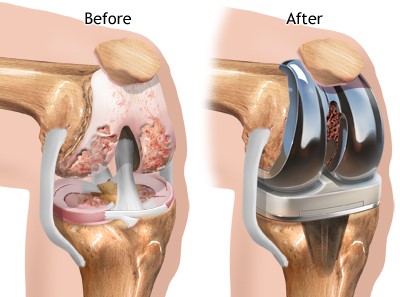
Total Knee Replacement
Total knee replacement (TKR) is a surgical procedure in which a damaged knee joint is replaced with an artificial joint, known as a prosthesis. It is usually performed for severe arthritis or other conditions that cause significant pain and limitation in knee function. After the surgery, the patient undergoes a period of rehabilitation to restore mobility, strength, and function. Here are some indications, precautions, and rehabilitation guidelines for total knee replacement:
Indications for Total Knee Replacement:
- Severe osteoarthritis or degenerative joint disease
- Rheumatoid arthritis
- Post-traumatic arthritis (due to injury)
- Avascular necrosis (loss of blood supply to the bone)
- Severe knee pain that limits daily activities and quality of life
- Failed previous knee surgeries or treatments
- Deformities in the knee joint
Benefits of TKR
Here are some benefits of knee replacement surgery:
1)Pain relief: One of the primary benefits of knee replacement surgery is significant pain reduction. People with severe knee damage often experience chronic pain that limits their ability to perform daily activities. Knee replacement surgery can alleviate this pain, enabling individuals to engage in a more active and comfortable lifestyle.
2)Improved joint function: Knee arthritis and other conditions can lead to stiffness, limited range of motion, and difficulty walking or climbing stairs. By replacing the damaged joint, knee replacement surgery can restore joint function, improve mobility, and increase flexibility. This allows individuals to perform activities that were previously challenging or impossible.
3)Enhanced quality of life: Chronic knee pain and disability can have a significant impact on a person’s overall quality of life. Knee replacement surgery can greatly improve quality of life by reducing pain, increasing mobility and independence, and enabling individuals to participate in activities they enjoy, such as sports, hobbies, and social interactions.
4)Long-term durability: Knee replacement implants are designed to be durable and long-lasting. While the lifespan of an implant varies depending on factors such as the patient’s age, activity level, and implant type, most knee replacements can provide pain relief and functional improvement for 15 to 20 years or more. This long-term durability allows individuals to enjoy the benefits of the surgery for an extended period.
5)Psychological well-being: Chronic pain and limited mobility can take a toll on a person’s mental and emotional well-being. Knee replacement surgery can alleviate pain, restore function, and improve self-esteem and self-confidence. By regaining the ability to participate in activities and enjoy a more active lifestyle, individuals often experience a boost in their overall psychological well-being.
6)Faster recovery and rehabilitation: Advances in surgical techniques and post-operative rehabilitation protocols have led to shorter hospital stays and faster recovery times for knee replacement patients. While the recovery process varies for each individual, many people are able to resume normal activities and return to work within a few weeks to a few months after surgery.

Rehab and Recovery
Rehabilitation after Total Knee Replacement: Rehabilitation plays a crucial role in regaining knee function and mobility after TKR. The rehabilitation process is typically divided into three phases:
Early Postoperative Phase (Hospital Stay):
- Physical therapy begins shortly after surgery to prevent stiffness and promote circulation.
- Exercises focus on gentle knee movements, ankle pumps, and muscle activation.
- Patients start walking with the aid of a walker or crutches.
Intermediate Phase (Outpatient Rehabilitation):
- As the patient’s condition improves, they transition to outpatient physical therapy.
- Exercises are aimed at increasing knee range of motion, strengthening muscles, and improving gait and balance.
- Modalities like ice and heat may be used to manage swelling and pain.
Advanced Phase (Home Exercise Program):
- Patients continue exercises and activities at home to maintain progress made during outpatient rehabilitation.
- The focus is on further improving strength, flexibility, and functional movements.
- Low-impact exercises like cycling and swimming may be incorporated.
Precautions to be taken
Precautions after Total Knee Replacement: After TKR surgery, patients need to be cautious to ensure proper healing and minimize complications. Some precautions include:
Weight-bearing restrictions: Initially, patients may be restricted from bearing full weight on the operated leg. The surgeon or physical therapist will provide specific weight-bearing instructions based on the patient’s condition and surgical approach.
Avoiding falls: Patients should take precautions to prevent falls, as a fall could damage the new joint or hinder the healing process. The use of assistive devices like crutches or a walker may be necessary during the early stages of rehabilitation.
Preventing infection: Following the surgeon’s guidelines for wound care and maintaining good hygiene can help reduce the risk of infection.
Medication management: Patients may be prescribed pain medications and blood thinners to manage pain and prevent blood clots. It’s essential to take medications as directed and communicate any concerns or side effects with the healthcare team.
No high-impact activities: High-impact activities, such as running or jumping, should be avoided, as they can put excessive stress on the new joint and lead to complications.
